 Wednesday, December 16, 2009
Wednesday, December 16, 2009My COP15 Journal: Day Thirteen
A few years ago, when the Local Agenda-21 group for Copenhagen (Agenda 21 was the name of the sustainable development plan the UN launched at the Earth Summit in Rio) started to look at what kind of changes might be needed to place the city on a more sustainable path through the challenges of the coming century, they requested a guided tour of Christiania.
Christiania began as a squat of an old abandoned military base in 1971 by a group of activists who wave in town for an international arts festival. It has had a tenuous relationship ever since, periodically being evicted by the city, then rioting, then holding to a restless armistice until a new government again tries to “normalize” the neighborhood. Because it is a Freetown, its population is neither well-heeled nor erudite. There are not many university degrees and more than a few drug addicts, deranged and demented, single mothers, fugitives and economic refugees who wind up there for lack of any better choices, either in Denmark or the scores of other countries from which they flee. It is on this foundation, rather than spiritual or intentional community, that the consensus democracy of Christiania has been cobbled.
Four years before the United States passed the National Environmental Policy Act, creating the EPA, Christiania’s Declaration of Goals stated: “our collective endeavor must constantly prove that mental and physical pollution can be overcome.”
The citizens of Christiania believe strongly that collective right of use is important 1) to allow room for all, 2) to support the a great diversity of population and, 3) to support the remarkable level of social freedom and justice that exists and is cherished by all residents.
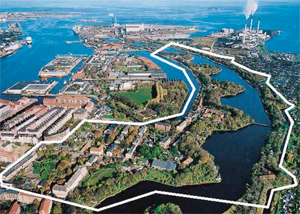 When the government group came to Christiania they had been expecting the worst — drug dealers, drunks, garbage in the streets. What they discovered shocked them. Christiania had set up a planning office in the 1980s and created a green master plan. By 2003, this had evolved into an ecovillage plan and many of the goals had already been realized. Christiania covers an area of more than 85 acres and houses almost one thousand inhabitants, and every year more than a million people visit the Freetown.
When the government group came to Christiania they had been expecting the worst — drug dealers, drunks, garbage in the streets. What they discovered shocked them. Christiania had set up a planning office in the 1980s and created a green master plan. By 2003, this had evolved into an ecovillage plan and many of the goals had already been realized. Christiania covers an area of more than 85 acres and houses almost one thousand inhabitants, and every year more than a million people visit the Freetown.
Directly inside the entrance to Christiania there is a Reuse Station, which was established well before we first visited in 1990. The site serves both Christiania and Christianshavn. The effort has always been towards 100% re-use, only recycling what cannot be reused. Unlike other recycling centers where people are not allowed to take away, Christiania encourages rummaging and only restricts items which are hazardous from being taken away.
Water is gathered on the roof of the Reuse Station, as well as from the roofs of many other buildings, and used for groundskeeping, flush toilets, and gardens. Water treatment systems also employ rainwater catchment to treat sewage and greywater with phytoremediation. Nutrients are kept from entering the nearby freshwater inlets and causing algae blooms.
In areas without a sewage system, composting toilets are used. In order to reduce the amount of waste, Christiania employs decentralized composting of home organic materials. To ensure it is done correctly, the Freetown has a “smell police,” that patrols the sites and peers into bins. If a problem is found, the users are given guidance on best practices.
Many of Christiania’s communal buildings are equipped with systems that reduce energy requirements, including solar collectors, PV panels, and windmills. Christiania’s communal bathhouse receives about half its hot water from solar in summer. Since 2001, Maelkevejen (Milky Way) has been working on a communal heating system which is well on its way to providing all the houses, clubs and businesses in the area ecologically sustainable heating. Heat is partially biomass (wood and pellets) and partially solar. The Freetown as a whole has invested in 61 shares in regional windmill energy.
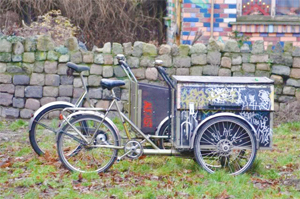 Not only is Christiania the first car-free neighborhood of Copenhagen, it has also created the Christiania Bike, which is one of its major industries. Various models developed since the business began in 1984 are now in use around the city and country to haul children, animals, products, and even carry the mail (Post Danmark). Copenhagen is now the largest city in the world to transport the majority of its children to school daily by bicycle.
Not only is Christiania the first car-free neighborhood of Copenhagen, it has also created the Christiania Bike, which is one of its major industries. Various models developed since the business began in 1984 are now in use around the city and country to haul children, animals, products, and even carry the mail (Post Danmark). Copenhagen is now the largest city in the world to transport the majority of its children to school daily by bicycle.
In the Green Hall, another of Christiania’s businesses, you can purchase donated, recycled, and salvaged building materials for construction. Most of the buildings are either remodeled from the original army barracks, warehouses and stables or do-it-yourself artistic expressions. The Freetown’s Building Office provides development and guidance for projects. Naturally, the Reuse Center is built entirely of reused materials.
Christiania deserves special recognition for its social system, called “From Here to There” (Herfra og Videre) which includes a social welfare service open to all comers (legal and illegal), an employment center, a health care service and Christiania’s own “Health House” (free clinic). Christiania works with partner organizations to resolve complex social problems.
One of the hallmarks of the ecovillage, one of the members of the Danish Ecovillage Network (LØS), is the peaceful coexistence of Christiania’s disempowered and underserved inhabitants with the affluent neighbors in Christianshavn. There is a distinctive bond that honors art in all its forms, participatory democracy, and the free spirited culture of Copenhagen.
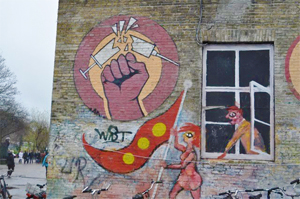 Christiania is more than an ecovillage, it is a “Green Urban Biotope;” with preserved native wetlands, 100 species of migratory birds, and a distinctively Nordic approach to nature spirituality and social responsibility. Earth Care, People Care, Surplus Share. Few other places so embody the permaculture credo.
Christiania is more than an ecovillage, it is a “Green Urban Biotope;” with preserved native wetlands, 100 species of migratory birds, and a distinctively Nordic approach to nature spirituality and social responsibility. Earth Care, People Care, Surplus Share. Few other places so embody the permaculture credo.
After their tour, the Agenda-21 group had much to ponder. They went back to their ministry offices and wrote up their reports. Christiania was declared Denmark’s first Agenda-21 whole systems model. It became the model for Copenhagen’s own green master plan. The fruit of the seed Christiania planted is now on display for 150 nations to experience.
This morning we awoke to 4 inches (10 cm) of fresh snow on the ground. Since then another 4 inches has fallen and it continues to come, in big flakes. We spent most of the day at the Bottom Up meeting and chose to take our news feeds of the Top Down from the internet and local sources. The Bella Center is becoming an increasingly inhospitable place, from all accounts.
No sooner did we begin praising Connie Hedegaard, the former Danish environmental minister, for her courageous stand Tuesday night, than she abruptly resigned in the middle of the all-night session. Her exit means that Danish Prime Minister Lars Rasmussen, the same fellow who was circulating a weak draft agreement to the G8 prior to the main negotiations, will preside over the final COP segment involving heads of state. Hedegaard will continue overseeing the closed-door negotiations between the G77/China and the rich countries over climate debt. Hedegaard said the move was merely procedural, and that it was more appropriate for Rasmussen to preside over the final stages when over 100 heads of government will be present.
The developments followed a dramatic night during which high level negotiations carried on till 5 am. US diplomats inserted brackets at numerous places in the negotiating text for the long term action plan. This effectively blocked discussions on the primary negotiating track. NGOs and G77 countries were incensed.
In every COP previously, most technical aspects of negotiation were finished by Wednesday of the second week. The decision drafts were then submitted to environment ministers for all countries. Brackets are inserted where there are disagreements which have to be resolved by the last day. The key brackets inserted by the parties were these:
Parties [shall] [should] collectively reduce global emissions by at least [50] [85] [95] per cent from 1990 levels by 2050 and [shall] [should] ensure that global emissions continue to decline thereafter.Moreover, by the end of Wednesday, the text remains extremely vague in some areas. For example, all of these topics are listed in the text as “to be elaborated:"
1. Various approaches, including opportunities to use markets, to enhance the cost-effectiveness of, and to promote, mitigation actions;
2. Policy approaches and measures to limit and reduce greenhouse gas emissions from aviation and marine bunker fuels;
3. Agricultural programmes; and
4. Near-term opportunities for mitigation
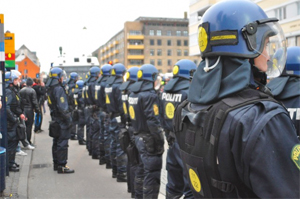 To “seal the deal,” these details need to be filled in through discussion among ministers and technical staff in the next two days, and then agreed upon by the heads of state on Friday. We can expect the Bella Center to be chaotic both inside and out, and it is not unreasonable to suspect the conference may carry over to Saturday.
To “seal the deal,” these details need to be filled in through discussion among ministers and technical staff in the next two days, and then agreed upon by the heads of state on Friday. We can expect the Bella Center to be chaotic both inside and out, and it is not unreasonable to suspect the conference may carry over to Saturday.
This morning demonstrators inside the COP who were staging a walk-out bumped into demonstrators outside the COP who were trying to get in. Police fired pepper spray to help them clear their heads and maybe get more organized. Naomi Klein, who was among those who joined the walkout, said the Danish police's handling of the protests was very poor. "Denmark is losing its reputation for being a good world citizen," she said. Tom Goldtooth of the Indigenous Environmental Network beat a drum from one of the crosswalks to try to help muster a sense of purpose.
At the badge scanning stop, after the xrays and magnet portals, several accredited environmental groups, including Friends of the Earth, Avaaz, Via Campesina and TckTckTck, were refused entry to the conference, apparently because they philosophically supported civil protest as a valid tactic. One of the people denied access to the summit was Stuart Eizenstat, the US chief negotiator at Kyoto.
It is easy to find climate villains (Canada, USA, Saudi Arabia, India) and climate heroes (Maldives, Tuvalu, and sometimes even China) but such labels polarize and build barriers to the deal the planet most urgently needs. We should be trying to avoid framing the discussion the way most of the media likes to — as a horse race or a good versus evil clash.
Procrastination and delay gambits are being exposed. Backroom deals are being exposed. Shoddy numbers are being exposed. Now heavy handed goon tactics are being exposed. We need to do that and then get back to the central focus. Too many NGOs are getting swept up in righteous indignation or the heat of the moment.
In a new study published today in the journal Nature, sea levels around the world during the last interglacial were determined to fall between 6.6 and 9 meters higher than today. That was during a period when temperatures were 2 to 3C above pre-industrial levels. This validates the concerns of island nations that 2 degrees is not a safe target. That may also mean that 35o is not ambitious enough.
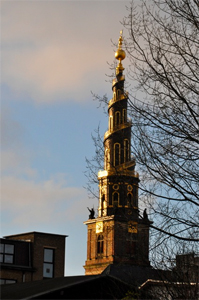 Bolivian President Evo Morales called on the world leaders to raise their ambitions radically and hold temperature increases over the next century to just 1C. In the most provocative statement yet made at the climate summit, Morales demanded rich countries pay climate change reparations and proposed an international climate court of justice to prosecute countries for climate "crimes.”
Bolivian President Evo Morales called on the world leaders to raise their ambitions radically and hold temperature increases over the next century to just 1C. In the most provocative statement yet made at the climate summit, Morales demanded rich countries pay climate change reparations and proposed an international climate court of justice to prosecute countries for climate "crimes.”
"Our objective is to save humanity and not just half of humanity. We are here to save mother earth. Our objective is to reduce climate change to [under] 1C. [Above this] many islands will disappear and Africa will suffer a holocaust," he said.
This came the same day that the United States announced it would accept the proposal Morales advanced more than two years ago, of paying Bolivia and other countries to keep their forests standing and their resources in the ground. At the time, Morales’ proposal was scoffed at as totally outrageous. The time may come when climate crimes are also not considered outside the bounds of legal process. Are you listening, Barack?
* * * * *
Follow Albert's adventures in Copenhagen and Hopenhagen on his blog. For more on his peak oil work, see the Culture Change article Albert Bates, guide for our post-petroleum, globally warmed future. For more articles on or by Albert on this website, visit this listing
For official news from the UNFCCC, visit their website starting with their Fact Sheets page. More than 15,000 participants, including delegates from 192 countries, are expected to take part in the UN Climate Change Conference in Copenhagen (7 to 18 December).

